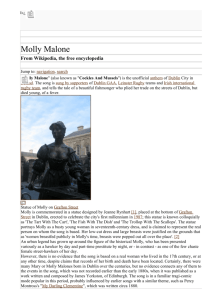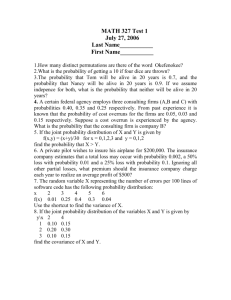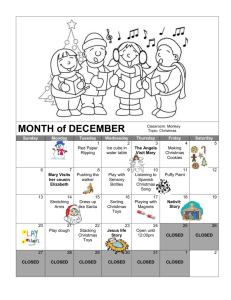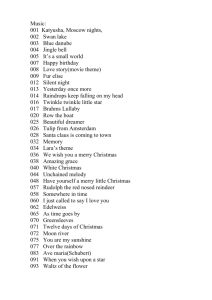contents poetry
advertisement
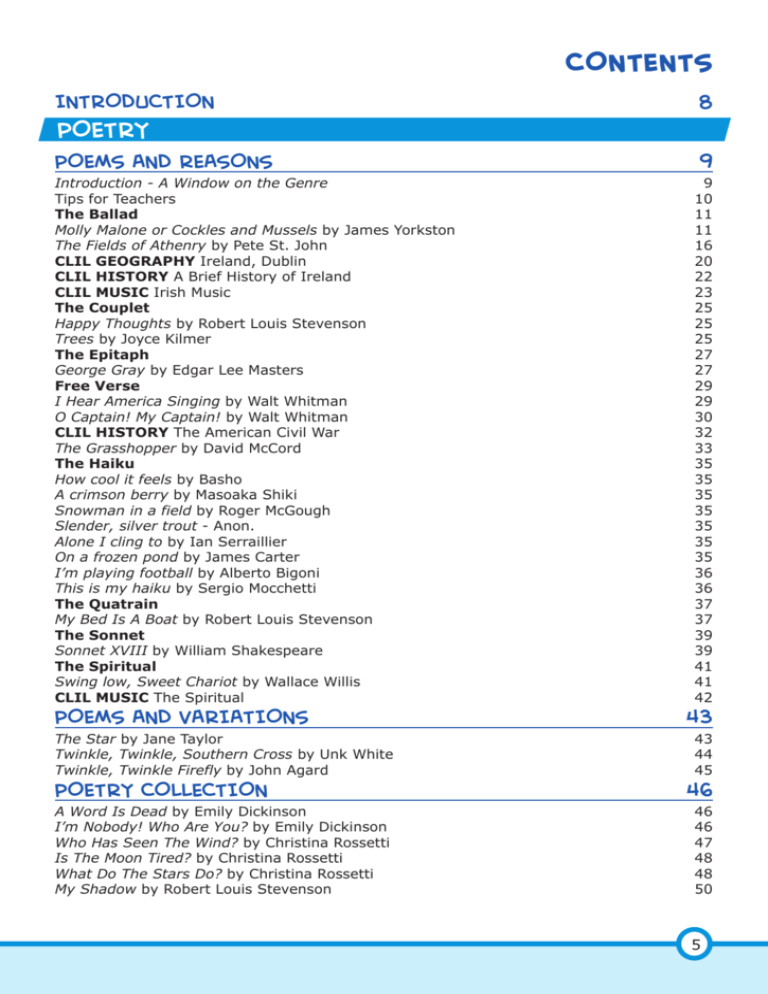
CONTENTS INTRODUCTION 8 POETRY POEMS AND REASONS Introduction - A Window on the Genre Tips for Teachers The Ballad Molly Malone or Cockles and Mussels by James Yorkston The Fields of Athenry by Pete St. John CLIL GEOGRAPHY Ireland, Dublin CLIL HISTORY A Brief History of Ireland CLIL MUSIC Irish Music The Couplet Happy Thoughts by Robert Louis Stevenson Trees by Joyce Kilmer The Epitaph George Gray by Edgar Lee Masters Free Verse I Hear America Singing by Walt Whitman O Captain! My Captain! by Walt Whitman CLIL HISTORY The American Civil War The Grasshopper by David McCord The Haiku How cool it feels by Basho A crimson berry by Masoaka Shiki Snowman in a field by Roger McGough Slender, silver trout - Anon. Alone I cling to by Ian Serraillier On a frozen pond by James Carter I’m playing football by Alberto Bigoni This is my haiku by Sergio Mocchetti The Quatrain My Bed Is A Boat by Robert Louis Stevenson The Sonnet Sonnet XVIII by William Shakespeare The Spiritual Swing low, Sweet Chariot by Wallace Willis CLIL MUSIC The Spiritual POEMS AND VARIATIONS The Star by Jane Taylor Twinkle, Twinkle, Southern Cross by Unk White Twinkle, Twinkle Firefly by John Agard POETRY COLLECTION A Word Is Dead by Emily Dickinson I’m Nobody! Who Are You? by Emily Dickinson Who Has Seen The Wind? by Christina Rossetti Is The Moon Tired? by Christina Rossetti What Do The Stars Do? by Christina Rossetti My Shadow by Robert Louis Stevenson 9 9 10 11 11 16 20 22 23 25 25 25 27 27 29 29 30 32 33 35 35 35 35 35 35 35 36 36 37 37 39 39 41 41 42 43 43 44 45 46 46 46 47 48 48 50 5 52 54 55 57 61 63 The Road not Taken by Robert Frost Fog by Carl Sandburg Buffalo Dusk by Carl Sandburg CLIL GEOGRAPHY & HISTORY Kansas and The Story of Cowboys The Noise of Waters by James Joyce In Time of Silver Rain by James Langston Hughes POEMS AND PRAYERS 64 Chester Cathedral Refectory Prayer by Thomas Harry Basil Webb Spring Prayer by Ralph Waldo Emerson Let No One Steal Your Dreams by Paul Cookson Our Father Who Art in Heaven, Glory be to the Father Hail Mary Summing up Like crystalline chips by Claudio Campi Climbing with effort by Valentina Vismara 64 66 67 68 68 70 70 70 NARRATIVE AUTOBIOGRAPHY 71 Introduction - A Window on the Genre from Boy, Chocolates chapter IV, by Roald Dahl CLIL TECHNOLOGY How chocolate is made from My First 79 Years, Facing a tough decision, ch. I, by Isaac Stern and Chaim Potok from My First 79 Years, My first violin, chapter I, by Isaac Stern and Chaim Potok CLIL HISTORY Jewish Immigration in the USA CLIL ART Far from the Motherland: Marc Chagall CLIL GEOGRAPHY American Cities: New York and San Francisco Summing up 71 72 76 78 80 82 83 84 86 DETECTIVE STORIES Introduction - A Window on the Genre from A Study in Scarlet, Mr. Sherlock Holmes, chapter I, by Sir Arthur Conan Doyle A selection from A Study in Scarlet, The Five Orange Pips, A Scandal in Bohemia and The Sign of Four, by Sir Arthur Conan Doyle from Murder on the Orient Express, The Body, Part I, chapter VII by Agatha Christie from The Mysterious Affair at Styles, chapter II, Monsieur Poirot by Agatha Christie CLIL HISTORY The Victorian Age Summing up FANTASY Introduction - A Window on the Genre from The Lion, the Witch and the Wardrobe, Introduction, by C. S. Lewis from The Lion, the Witch and the Wardrobe, Lucy Looks into a Wardrobe, chapter I by C. S. Lewis from The Lion, the Witch and the Wardrobe, What Lucy Found There, chapter II by C. S. Lewis BRITISH CULTURE PROJECT English Tea & Recipes CLIL HISTORY The Second World War: the Battle of Britain and The Blitz CLIL ART The Devastation of War: Guernica from The Hobbit, chapter I, An Unexpected Party, Bilbo Baggins and his Hobbit-Hole by J. R. R. Tolkien from The Hobbit, chapter I, An Unexpected Party, Hobbits by J. R. R. Tolkien from Harry Potter and The Philosopher’s Stone, chapter VII The Sorting Hat, by J. K. Rowling Summing up 6 87 87 88 92 95 104 105 107 108 108 109 110 113 115 116 119 120 122 123 128 SCIENCE FICTION Introduction - A Window on the Genre from The Complete Short SF of Fredric Brown, Sentry by Fredric Brown from The Complete Short SF of Fredric Brown, The End by Fredric Brown from The Martian Chronicles, Ylla by Ray Bradbury Summing up CLIL SCIENCE The Solar System 129 129 130 133 134 138 139 CHRISTMAS CAROLS Introduction - A Window on the Genre The Virgin Mary had a Baby Boy Traditional Go Tell it on the Mountain by John Wesley Work, Jr. I Wonder as I Wander by Jacob Niles Letters from Father Christmas by John Ronald Reuel Tolkien Jesus’ Christmas Party by Nicholas Allan A Christmas Quiz CLIL RELIGION The true story of Christmas from the Gospel of Luke 2:1-11. GLOSSARY of terms ACKNOWLEDGEMENTS 142 143 144 146 147 149 151 152 153 155 7 POEMS AND REASONS THE BALLAD The ballad is a form of narrative verse, which was popular during the Middle Ages. It has been used by many English poets. Ballads are simple stories told in verses, and sometimes the last line tells the moral of the story, or gives a lesson of some kind. Ballads are often also songs, typical of country music. See the section on the quatrain (p.37). Molly Malone or Cockles and Mussels A2 Molly Malone is a ballad which is also known as Cockles and Mussels. If you’ve been to Ireland, you must have heard it. They call it Dublin’s anthem, the symbol of the city, and everyone sings it at sports events. It’s an Irish song, but, strangely, the first published version of it appeared in London in 1884, and it was attributed to James Yorkston of Scotland. The song speaks about a beautiful young woman who sold cockles and mussels on the streets of Dublin. She died from a fever while she was young, but her spirit still lives in the city of Dublin. If you walk down Grafton Street, in the centre of Dublin, towards Trinity College (which is the oldest university in Ireland), you’ll see a big bronze statue of Molly Malone. 2 by James Yorkston In Dublin’s fair city where the girls are so pretty, I first set my eyes on sweet Molly Malone, As she wheeled her wheelbarrow through the streets broad and narrow Crying “Cockles and mussels, alive, alive-oh!” Chorus “A-live, alive o-Oh! Alive, alive o-Oh!” Crying “Cockl-es and muss-els, alive, alive-oh!” She was a fishmonger and sure ‘twas no wonder For so were her father and mother before And they both wheeled their barrows through the streets broad and narrow Crying “Cockles and mussels, alive, alive-oh!” Chorus She died of a fever and no one could save her And that was the end of sweet Molly Malone But her ghost wheels her barrow through the streets broad and narrow Crying “Cockles and mussels, alive, alive-oh!”. Chorus stanza a group of lines forming the basic unit of a poem 11 fair (archaic use) beautiful set your eyes on noticed wheeled pushed fishmonger a person who sells fish ‘twas it was wonder surprise broad wide narrow not very wide alive living/not dead fever when the body temperature is higher than usual ghost spirit cockles mussels wheelbarrow fishmonger It’s your turn! A wOrk on words Match the words to the definitions or synonyms: 1. 2. 3. 4. 5. 6. 7. 8. 9. cockles and mussels wheelbarrow fever ghost fair fishmonger wide narrow wonder The statue of Molly Malone 12 a) b) c) d) e) f) g) h) i) surprise spirit beautiful seafood a person who sells fish a small cart large not very wide when the body’s temperature is too hot Trinity College Grafton Street B UNDERSTANDING THE TEXT Listen to the song many times, write the missing words from the box and then check the lyrics. fishmonger set mussels fair mother wheelbarrow sure pretty narrow cockles died was end streets ghost alive fever wheeled through broad In Dublin’s 1__________ city where the girls are so 2__________ I first 3__________ my eyes on sweet Molly Malone, As she wheeled her 4_________ through the 5_________ broad and narrow Crying “Cockles and 6__________ alive, alive-oh!” “Alive, alive o-Oh! Alive, alive o-Oh!” Crying, “7__________ and mussels, alive, alive-oh!” She was a 8__________ and 9__________ ‘twas no wonder For so were her father and And they both 10__________ 11__________ before their barrows through the streets broad and 12__________ Crying “Cockles and mussels, alive, alive-oh!” She 13__________ And that But her of a 15__________ 17_______ 14__________ the and no one could save her 16__________ wheels her barrow of sweet Molly Malone 18________ the streets 19________ and narrow Crying “Cockles and mussels, 20__________, alive-oh!”. C EXPLORING THE TEXT Find the rhymes! 1. city a. pretty 2. wheelbarrow b. 3. fishmonger c. 4. fever d. 13 D GRAMMAR FOCUS Put the verbs in brackets into the past form and then listen to the song to check for the answers. In Dublin’s fair city where the girls are so pretty I first 1___________ (set) my eyes on sweet Molly Malone, As she 2___________ (wheel) her wheel barrow through the streets broad and narrow Crying “Cockles and mussels, alive, alive-oh!” “Alive, alive o-Oh! Alive, alive o-Oh!” Crying, “Cockles and mussels, alive, alive-oh!” She 3___________ (be) a fishmonger and sure ‘twas no wonder For so 4___________ (be) her father and mother before And they both 5___________ (wheel) their barrows through the streets broad and narrow Crying “Cockles and mussels, alive, alive-oh!” She 6___________ (die) of a fever and no one could save her And that 7___________ (be) the end of sweet Molly Malone But her ghost wheels her barrow through the streets broad and narrow Crying “Cockles and mussels, alive, alive-oh!”. E CREATING Listen to the song and put the pictures in the right order. 14 1. G 2. 3. 4. 5. 6. 7. 8. 9. 10. 11. 12. 13. 14. A B C D E F G H I J K L M N F UNDERSTANDING THE TEXT Answer the questions: 1. What does the ballad Cockles and Mussels speak about? 2. Who is the author? 3. When was it published? 4. Who was Molly Malone? 5. Where did the author see her for the first time? 6. What was she saying? 7. How did she die? 8. Who wheels her barrow through Dublin at present? 9. In your opinion, what is the lesson we are told in the last line? G EXPLORING THE TEXT Answer the questions: 1. What is a ballad? 2. Why are ballads very popular nowadays? 3. When is the ballad Molly Malone sung? 4. Where can you find the bronze statue of Molly Malone? 5. What is Trinity College? 6. Have you ever read any other ballads? Give an example. 7. Which is your favourite one? Why? speaking Look at the pictures from exercise E and tell the story of Molly Malone in your own words. Howth, near Dublin, Lighthouse Dublin Bay 15 WRITING POETRY Now write your own ballad. ● Choose an event (from your own life, your personal experience, from the past, from history …) ● Write down as many details as you can about the chosen event, answering these questions: ● What? ● When? ● Where? ● How? ● .........? ● Write down the first draft of your ballad using the information you have collected. ● Write your story. ● Use as many verses and stanzas as necessary. ● Finish your ballad with a meaningful line or the moral of the story. ● Copy it out and draw a picture (or find one on the Internet) to illustrate your ballad. Galway Bay Cliffs of Moher, Ireland’s west coast 19 From The Lion, The Witch and The Wardrobe b1 Introduction by C. S. Lewis Clive Staples Lewis (1898-1963) was an Irish-born British novelist, academic, medievalist and literary critic. He is very famous for his fiction, especially The Screwtape Letters, The Chronicles of Narnia and The Space Trilogy. He was a close friend of J.R.R. Tolkien. With some other friends from the English faculty at Oxford University, he founded a literary group known as the 'Inklings'. He converted to Christianity at the age of 32 and his conversion had a profound effect on his work. He married the American writer Joy Gresham. He died on the same day that US President John F. Kennedy was assassinated. His works have been translated into more than 30 languages and have sold millions of copies over the years. His most famous stories have also been made into films. 6 To Lucy Barfield My Dear Lucy, I wrote this story for you, but when I began it I had not realized that girls grow quicker than books. As a result you are already too old for fairy tales, and by the time it is printed and bound you will be older still. But some day you will be old enough to start reading fairy tales again. You can then take it down from some upper shelf, dust it, and tell me what you think of it. I shall probably be too deaf to hear, and too old to understand, a word you say, but I shall still be your affectionate Godfather, C. S. Lewis The Chronicles of Narnia is a series of seven fantasy novels for children. Written between 1949 and 1954, the books contain Christian ideas intended to be easily accessible to young readers. In addition to Christian themes, Lewis borrows characters from Greek and Roman mythology, as well as from traditional British and Irish fairy tales. “I've seen landscapes which, under a particular light, make me feel that at any moment a giant might raise his head over the next ridge.” C. S. Lewis On Stories The Mountains of Mourne that inspired him to write The Chronicles of Narnia bound past participle of to bind/bound/bound, when the pages of a book are put all together to dust to take dust (a dirty powder contained in the air) godfather a man who sponsors a person at baptism 109 From THE LIoN, THE WITCH AND THE WARDRoBE by C. S. Lewis Chapter II What Lucy Found There The Faun’s name was Mr. Tumnus. It turned out he was more afraid of Lucy than Lucy was of him. And Lucy couldn’t resist his invitation for tea – she was dying to get out of the cold. On the way to his house, Lucy discovered that she was in a land called Narnia, where it had been winter for the last one hundred years. “Winter’s all right,” Lucy said, trying to sound cheerful. “You can ice skate and have snowball fights. And Christmas!” Mr. Tumnus shook his head. “Not here,” he replied sadly. “We haven’t had Christmas for a hundred years”. b1 Focus on setting 8 Tumnus’s Place Lucy thought she had never been in a nicer place. It was a little, dry, clean cave of reddish stone with a carpet on the floor and two little chairs (“One for me and one for a friend,” said Mr. Tumnus) and a table and a dresser and a mantelpiece over the fire and above that a picture of an old faun with a grey beard. In one corner there was a door which Lucy thought must lead to Mr. Tumnus’s bedroom, and on one wall was a shelf full of books. Lucy looked at these while he was setting out the tea things. They had titles like The Life and Letters of Silenus or Nymphs and Their Ways or Men, Monks and Gamekeepers; A Study in Popular Legend or Is Man a Myth? “Now, Daughter of Eve!” said the Faun. And really it was a wonderful tea. There was a nice brown egg, lightly boiled, for each of them, and then sardines on toast, and then buttered toast, and then toast with honey, and then a sugar-topped cake. And when Lucy was tired of eating, the Faun began to talk. When Lucy decided to leave, Mr. Tumnus seemed scared. “If I let you go, she’ll turn me to stone,” he whispered. “The White Witch! She’s the one who makes it always winter. She gave orders… if we ever find a Human in the woods, we’re supposed to turn it over to her.” Mr. Tumnus broke the rules by helping her leave. Lucy just hoped he wouldn’t get caught. And s h e stepped back through the wardrobe. to lead (led/led) to go to, take you to to set out (set/set) to put out, place to turn to to transform to turn over to to give in the hands of stepped back past tense of to step back, to go back sugar-topped cake mantelpiece dresser 113 It’s your turn! A UNDERSTANDING THE TEXT Answer the following questions: 1. Why is Mr. Tumnus friendly to Lucy? 2. Why does Lucy accept his invitation? 3. What's the weather like in Narnia and why? 4. Who is Mr. Tumnus afraid of and why? 5. In your opinion, what is the White Witch afraid of? B EXPLORING THE TEXT Fill in the chart with the information you find in the text: Tumnus's place 114 The tea table PROJECT ON THE WEB world war ii As you have learnt from the previous pages, during World War II, German fighter planes conducted air-raids against Great Britain. They dropped hundreds of bombs on the cities - including England's capital city, London. Whenever possible, British parents sent their children to live with friends and relatives out in the country where it was much safer. That's why, in The Lion, the Witch and the Wardrobe, the four children find themselves at the Professor's house. - To find out more about the time in which this story takes place, use the Internet, a dictionary, an encyclopedia, or a history book to answer the questions. - Go to www.itacalibri.it, write Enjoy Literature! into the search engine, then find the website related to this project to find useful links. 1. When did World War II begin? ______________________________________________________________ 2. When did it end? ______________________________________________________________ 3. Which countries fought in the War? ______________________________________________________________ 4. Describe some of the causes of the War: ______________________________________________________________ ______________________________________________________________ 5. List some of the major battles or events: ______________________________________________________________ ______________________________________________________________ 6. Name some historical figures who played an important role in the War. Say what they did. ______________________________________________________________ ______________________________________________________________ ______________________________________________________________ 7. What was the outcome of the War? ______________________________________________________________ 118 The Devastation of War: Guernica "The artist is a receptacle for emotions that come from all over the place: from the sky, from the earth, from a scrap of paper, from a passing shape...". Pablo Picasso b1 clil art Picasso painted Guernica, a huge mural, in 1937 after German and Italian warplanes had bombed this small city in the Basque Country during the Spanish Civil War. The bombing took place on a market day; a lot of people were in the city centre and were unable to escape because the streets were soon filled with debris and the bridges destroyed. Moreover, men were away fighting in the war and the town was populated mostly by women and children. Guernica shows the tragedy and the suffering brought on innocent people by war. Over the years, this mural has become the symbol of anti-war feeling. It’s your turn! A Reading a painting Look carefully at the mural and then complete the reading of the painting using the words from the box. soldier - blades - entrapped - woman - horse - flower - raised - bull - flame head - child - blankly - cell - window - eye - candle - hope On the left you can see a ________ near a ________ who is crying over a dead ________ in her arms. The bull's tail takes the form of a ________. In the centre a ________ in agony becomes the focus of the painting. Under the horse there is a dead ________. There is a ________ growing out from his sword. There is a light shaped like an evil ________ over the horse's ________. It resembles the bulb of an interrogation ________. On the right there is a woman coming out of a ________. She is very frightened and carries a ________ in her right arm which symbolises ________. There is another woman looking ________ at the bulb. Some characters have ________ instead of tongues in their mouths. On the right a figure with arms ________ in terror is ________ by fire. (adapted from en.wikipedia.org) 119 A2 Letters From Father Christmas by John Ronald Reuel Tolkien John Ronald Reuel Tolkien (1892-1973) was born in South Africa of English parents. When he was four years old, his mother took him back to England and there he had a happy childhood in the country. His writings and his pictures clearly show his love for nature and landscapes. He liked imaginary worlds and began to write about them. In 1925 he became a Professor at Oxford University. He is known for his books of fiction, The Hobbit, The Lord of The Rings, and The Silmarillion. He also wrote many books for his children, among them the Father Christmas Letters. For over twenty years, every December Tolkien wrote letters to his children John, Michael, Christopher and Priscilla. The letters were signed Father Christmas and on the envelope there was a stamp from the North Pole. Here is the first letter that he wrote to his son John, the eldest, who was three years old. Tolkien died after a very brief illness at the age of 82. 17 Christmas House, North Pole 22nd December 1920 Dear John I heard you ask daddy what I was like & where I lived. I have drawn ME & My House for you. Take care of the picture. I am just off now for Oxford with my bundle of toys – some for you. Hope I shall arrive in time: the snow is very thick at the NORTH POLE tonight. Yr loving Fr. Chr. drawn past participle of to draw/ drew/drawn, to illustrate bundle a number things held together A UNDERSTANDING THE TEXT Answer the following questions: 1. Who is the letter from? 2. Where is the letter from? 3. Where is he going tonight? 4. Why is he going to Oxford? 5. Who are the toys for? 6. What is the snow like tonight at the North Pole? 7. And why does he use the short forms in his signature? 147 18 Cliff House, North Pole November 30th 1932 My dear children Thank you for your nice letters. I have not forgotten you. I am very late this year and very worried – a very funny thing has happened. The Polar Bear has disappeared, and I don’t know where he is. I have not seen him since the beginning of this month, and I am getting anxious. Tomorrow December, the Christmas month, begins, and I don’t know what I shall do without him. I am glad you are all well and your many pets. The Snowbabies* holidays begin tomorrow. I wish Polar Bear was here to look after them. Love to Michael, Christopher and Priscilla. Please send John my love when you write to him. Father Christmas. *A snow baby is a small figurine that represents some aspects of the Christmas holidays or of winter sports. The traditional snow baby is made of porcelain and shows a child dressed in a snowsuit. Santa Claus, elves and gnomes, animals such as penguins and polar bears are often associated with these snowy children. forgotten past tense of to forget/forgot/forgotten, not remember It’s your turn! A exploring the text Answer the following questions: 1. Why is Father Christmas so late and worried this year? 2. What month is it at present? 3. What does it begin tomorrow? 4. Why does Father Christmas need Polar Bear? 5. What kind of character is Polar Bear? Try to imagine and say why. B reading pictures Look at the picture: 1. What is a ‘bundle’? 2. Describe Father Christmas to a friend using the picture. 3. Describe Father Christmas’s house. C WRITING Imagine you are writing back to Father Christmas. Describe yourself and your house. Describe it very well, otherwise Father Christmas won’t find your house and won’t leave you any toys! Make a list of all the things you would like to get for Christmas. D DRAWING J.R.R. Tolkien is very good at drawing: look at the stamp he drew on p. 147 and make up your own post stamp from or to the North Pole! 148
